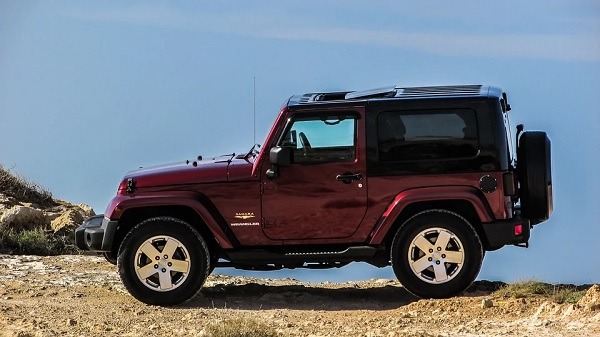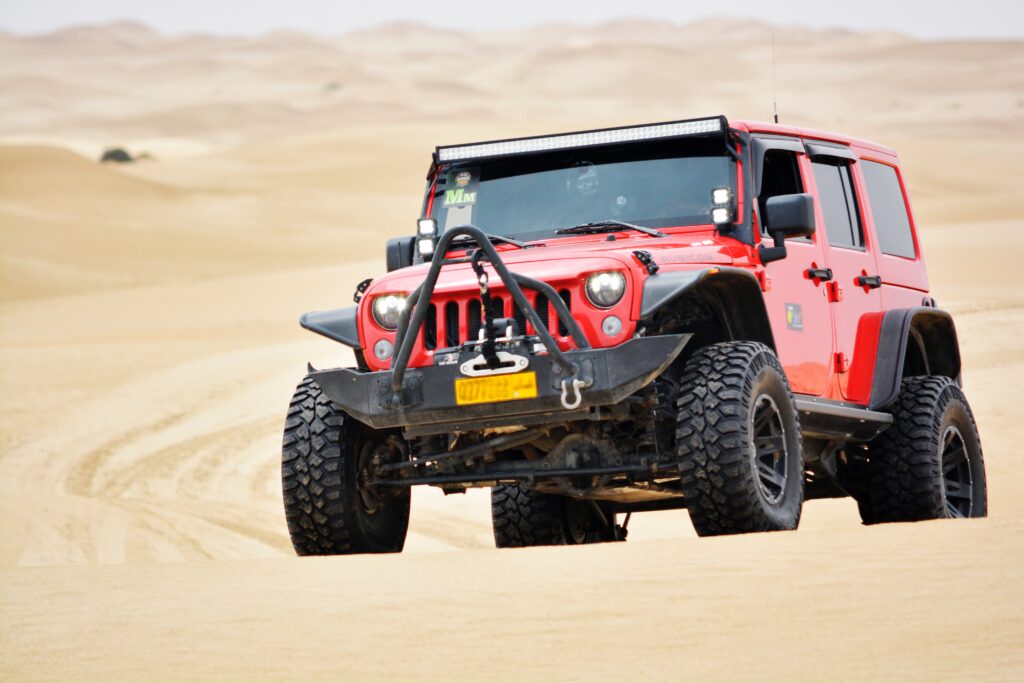Jeep fender flares are very popular modifications for the brand’s most famous model, the Wrangler. They look great and have some functional benefits for off-road builds. However, if you have never installed fender flares before, you may be unsure where to start. Even figuring out which size of fender flare to buy can be confusing at first.
What Are Fender Flares?
As you may already know, fenders are the body parts that fit over your wheels. Due to the angled shape of the front of a Wrangler and the relatively wide wheels, the fenders also feature flares. These are parts that protrude from the body of the vehicle to help offer additional coverage of the wheels. In the rear, stock fender flares are a little over an inch wide and in the front, they are several inches wide.
However, if you want larger, off-road tires on your Jeep, they may stick out from the stock fender flares. This helps to prevent dirt and debris from the road or trail from kicking up. In some jurisdictions, it is legally required to have a fender (or flare) that completely covers the tires.
In addition to providing extra coverage, fender flares look good. Plus, if you order aftermarket flares, you have the option to change up the style to suit your Jeep build.
Finding the Right Size
The most important considerations when selecting a flare size is the width of your Jeep wheels and tires. If you need extra space to accommodate your wheels, install them first and simply measure the gap between the edge of the flare and the tire. Alternatively, you can find a lot of information on product pages and Jeep forums about the size of fender flare required for specific tires.
Additionally, make sure that you check the legal requirements for your area. Unless your Jeep is intended for off-road use only (no license plate or registration), you will need to comply with the relevant laws. This may limit the types and sizes of flares that you can install. It may also require a minimum size based on your tires.
The length of flares is a little simpler and is generally standardized. If you are installing wide wheels, make sure you have plenty of coverage behind the wheels in the front. Otherwise, your passengers may get muddy.
Choosing Your Style
Once you have worked out the right size, you can select a style. There are OEM-lookalike fender flares that are simply wider than the normal. Alternatively, you may opt for a cool off-road style. Flat flares are very popular off-road. Tube flares are another popular option. Typically, it is best to have flares with a little bit of flexibility, especially if you plan to hit the trails.
1. Original Equipment (Factory) Style Flares
There are two types of OE Style Flares. The first is merely a replacement made of factory-style ABS plastic that gives identical performance, feel, coverage, and appearance to what came with the car at launch. This option is for people whose present flares have failed or have gotten damaged for whatever reason, and all that is required to replace them is to take the old ones away and put the new ones in.
Installation-wise, they bolt to all the original factory locations and sit flat against the body just like stock, so you can start driving right away.
However, there are also broader variations of the factory design that, even down to the style opening for the side marker lights, maintain the original appearance for certain people.
2. Flat Flares
This flare shape is arguably the most well-liked alternative now available, and it is especially favored by people who need more clearance and prefer better approach angles while tackling off-road hazards. Flat flares also provide a touch of history and an appearance that demands attention because they are based on the original Willys Jeep fender design.
It is a design that also exudes toughness, adaptability, and durability because the majority of flat flares are made of UV-treated thermoplastic that is incredibly flexible and durable and is available in a range of widths. They can all bend during a collision without ripping or harming the car’s body and they can all withstand sun fading. In contrast, an off-road rock (or other foreign object) can cause the ABS plastic on manufactured flares to distort or even pull off.
Back to the major feature, though. Flat flares provide an extra 2″ of space in the wheel well for increased tire clearance, which is unquestionably useful when engaging in more extreme off-road driving. When using the original flares, tires frequently scuff up against them during more severe tire articulation, which might potentially harm the flare. When it comes to general protection of dirt, mud, and gravel spray, these aftermarket flat flares may not be at the front of the class due to their high clearance.
3. High Clearance Flares
Prior until recently, the majority of aftermarket fender flares had the flat flare style and had a larger clearance. Do not misunderstand us; those are, as we already stated, a cool, retro setup. But not everyone might find it appealing.
Therefore, there are new high clearance fender flare choices for anyone driving a current-generation Wrangler JL that provide a great method to keep your car looking factory-style while fitting bigger tires without having to install a suspension raise.
To provide you the room you need when off-roading so the tire won’t make contact with the fender or inner fender liner at extreme articulation, the high clearance option entails up to three inches more clearance above factory flares and around 5/8 inches more width.
Most high clearance flare choices are made to fit with the factory inner liner or most aftermarket versions of the Wrangler JL’s current turn signal and daytime running light (DRL) assembly. Additionally, high-density thermoplastic is typically used in the construction of these flares to boost longevity and widestand the majority of trail damage.
4. Pocket Flares
The extra-wide version of these flares give more tough design cues replete with “pockets,” or rivets, encircling multiple more bolt holes on the flare. Pocket Flares approximate the bulkier factory flare look. With a broader vehicle stance and an eye-catching strong style, the product looks terrific whether it is an off-road vehicle or a daily driver.
The majority of these flares also provide significantly more tire coverage than the factory stock flares—up to 6″ for CJ, YJ, and TJ and 11.75″ for JK—and are arguably the best flare designs for capturing tire debris and preventing it from hitting your Jeep’s body or other nearby vehicles. However, due to all of the extra material, they do not provide much additional room for off-road tire clearance.
Many of these flares can withstand everything you throw at them if you do take the car off-road since they are made of UV-resistant ABS plastic, which keeps them flexible and strong. Additionally, although there are many extra stainless steel bolts that give the flares that aggressive appearance, most do not extend to the body, and installation is not a difficult operation because the flares attach directly to factory mounting positions. Drilling is used in several earlier car designs.
5. Tube Flares
The majority of the time, tube flares imitate flat flare variants’ design cues. However, tubular flares are made of steel or aluminum, whereas flat flares use a thermoplastic composition that offers the product flexibility. The flare’s outside border is then completely covered with a solid tube to increase strength and longevity.
For individuals who want better off-road performance, tubular flares are also fantastic since the greater space between the tire and flare enables better tire articulation that won’t scuff the flare.
The availability of several sizes ranging from tight coverage up to 10″ broad is another characteristic that is identical to the flat version. Again, the narrow flare design can be handy if your off-road activities take you down really tiny paths. Alternatively, you can go bigger to assist shield the body from dirt, mud, and road debris—while still obtaining enough of tire clearance area.
Although quite strong, these metal flares won’t bend in response to contact, so keep that in mind. Therefore, more flexible flat flares are definitely a better option if your off-road excursions frequently include a lot of scraping and bashing.
Tubular flares are typically mounted using the original mounting points, however some need enlarging one (or more) of those holes to accommodate bigger hardware, and some rear flare installations require pop rivets.
Decide on Fender Flare Coverage
If you’re purchasing fender flares to cover rust or other damage, or to meet law requirements for tire coverage, you’ll want to pay attention to the height and tire coverage measurements we have listed for each fender flare.
The height of a fender flare is how far up the fender the flare will cover. This is typically measured from the point at the top of the fender; as the flare curves, this measurement can vary slightly to conform with the styling and body lines. This measurement is important for customers looking to hide rust or other body damage.
The tire coverage measurement is important for those with larger tires or may be interested in larger tires in the future. It is a measurement of how far out your fender flares will protrude from the vehicle. You will want enough coverage to lawfully abide by your state’s laws regarding tire coverage.
Compare the Brands
The brand must be well-respected, have high customer satisfaction ratings, and backed by a company that values its customers and products. In the rare event of a manufacturer’s warranty issue, make sure as customer, you are fully supported.
Scour for trade shows, listen to other customers, and talk to suppliers and brands to find products that will you value. Fender flares aren’t cheap – that’s you need to make sure your purchase lasts the lifetime of your vehicle and that your warranty is fully backed.
If you choose to purchase a set of painted fender flares, be sure that its painters are accredited, and professional body shops utilize the latest technologies to ensure a computer-coded match. What does that mean in the end? It means it has an extremely high success rate in getting that perfect paint match, so all you have to worry about is making sure your flares stay shiny on the road.
Get Started Today
With the right fender flares, a Jeep winch and a few other accessories, you will be ready for the trails. Shopping for the right parts for your Jeep can be a lot of fun. It is even better when your build comes together and looks amazing. So, get started today and create your ultimate Jeep.
Conclusion
The natural fender on your Jeep is extended by a fender flare. When your tires are either large or offset, it works best. They aid in making sure your Jeep complies with the vehicle equipment laws. As they function like a fender to prevent pebbles and other objects from striking the body of your car, they can also help to preserve the value of your car. For compliance and to guarantee that they provide the appropriate amount of protection against anything your vehicle kicks up as you drive, it is crucial that they be placed correctly. Overall, they create a more gritty appearance that is ideal for a Jeep.



